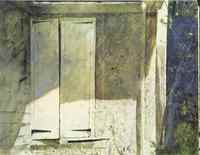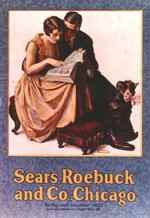|
Vincent Price Collection of Fine Art
In 1962, art was not really new to Sears. As early as
1895, Sears offered oil paintings at prices of 90 cents
and up. The services of many distinguished artists, such
as Andrew Loomis, McClelland Barclay and Norman Rockwell
had designed covers for the Sears catalog. Yet, company
executives observed that except for a few major cities,
fine art was virtually inaccessible to the general
public.

Artist's Studio" a watercolor by
Andrew Wyeth offered for sale by Sears' Vincent
Price Collection of Fine Art in 1966. |
Sears set out to end this isolation by merchandising
art throughout the country, in a presentation from which
pictures could be readily purchased to enrich American
homes. Vincent Price was approached to take charge of
this program. Price, although well-known by the public
as an actor, was also known in the international art
world as a collector, lecturer, former gallery-owner and
connoisseur who spent a dozen years studying art at
Yale, the University of London and other art centers
abroad.
Price was given complete authority to acquire any
works he considered worthy of selection. He searched
throughout the world for fine art to offer through
Sears. He bought whole collections and even commissioned
artists, including Salvador Dali, to do works
specifically for this program.
At first, the idea of a large merchandising
organization, such as Sears, maintaining a serious,
top-quality art collection met with skepticism. But the
public - and the artists themselves - soon learned that
Sears would not compromise with good taste or artistic
quality.
On October 6, 1962, the first exhibit and sale of
"The Vincent Price Collection of Fine Art"
took place in a Sears store in Denver, Colo. Original
works of the great masters - Rembrandt, Chagall,
Picasso, Whistler and more - as well as those of the
best contemporary artists at the time were offered for
sale in this first exhibit and throughout the program's
existence.

Cover of the 1927 Sears Catalog featuring a
reproduction of a painting for Sears by Norman
Rockwell |
Items ranged in selling price from $10 to $3,000.
Sears customers could also purchase items on an
installment plan for as little as $5 down and $5 a
month. Each work in the program was guaranteed as an
original work of quality, just as Sears offered quality
guarantees on its lawnmowers and TVs. The program was an
instant success. So many pictures were snatched up the
first day that an emergency shipment had to be flown in
lest the walls be bare the next day.
The program expanded in the weeks that followed,
adding exhibits in 10 additional Sears stores including
Hartford, Conn., Harrisburg, Penn., San Diego, Calif.,
Evansville, Ind., Madison, Wis., and Oklahoma City,
Okla. After the successful exhibition and sale of these
first 1,500 pieces, the program was expanded nationwide
to all of Sears stores throughout the country, bringing
original works of fine art to the American public in
unprecedented quantity and quality.
Works from the collection were also offered for sale
through a special catalog in 1963 and 1964. In 1966, the
Sears Vincent Price Gallery of Fine Art was opened in
Chicago, Ill., providing a mass audience for talented,
but less well-known, young artists. The collection also
held temporary exhibits in several hundred communities
throughout the country and permanent galleries operated
in several cities
By 1971, when the program ended, more than 50,000
pieces of fine art passed through a constantly changing
collection into American homes and offices.
|



